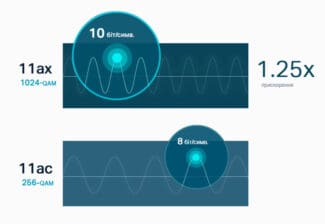The 802.11n standard provides for three modes: High Throughput (pure 802.11n), Non-High Throughput (fully compatible with 802.11b/g), and High Throughput Mixed (mixed mode).
AC standard Wi-Fi. Why an AC router is better than an N router
When you buy a 5GHz router, the word DualBand distracts our attention from the more important point, the Wi-Fi standard that uses the 5GHz carrier. Unlike the 2.4GHz carrier standard that we already know and understand, 5GHz devices can be used in conjunction with 802.11n or 802.11ac standards ( hereinafter AC standard and N standard).
The IEEE 802.11 group of Wi-Fi standards has evolved quite dynamically, from IEEE 802.11a, which provided speeds up to 2 Mbps2 Mbps, through 802.11b and 802.11g, which gave speeds up to 11 Mbps и 54 Mbps respectively. Then 802.11n or simply the n-standard appeared. The N-standard was a real breakthrough, since it was now possible to transmit traffic at the then unthinkable speeds through a single antenna 150Mbit.. This was achieved through the use of advanced coding technology (MIMO), more careful consideration of RF propagation, double channel width technology, non-static guard interval defined by such concepts as modulation index and coding schemes.
Operating Principles of 802.11n
The familiar 802.11n can be used in either of the 2.4GHz and 5.0GHz bands. On the physical layer, in addition to improved signal processing and modulation, it adds the ability to transmit simultaneously over four antennas, through each antennae can transmit up to 150Mbit/s, i.e. it is theoretically 600Mbit. However, given that the antenna is simultaneously working either for reception or for broadcasting, the data rate in one direction will not exceed 75Mbit/s per antenna.
Multichannel Input/Output (MIMO)
This technology was first available in 802.11n. MIMO stands for Multiple Input Multiple Output, which stands for Multiple Input Multiple Output.
MIMO allows multiple data streams to be simultaneously received and transmitted over more than one antenna.
The 802.11n standard defines different antenna configurations from "1×1" to "4×4". Non-symmetric configurations are also possible, such as "2×3" where the first value means the number of transmitting and the second the number of receiving antennas.
Obviously, the maximum transmission reception rate can only be achieved by using the "4×4" scheme. Actually, the number of antennas does not increase the speed by itself, but it allows the application of various advanced signal processing methods, which are automatically selected and applied by the device, including based on the configuration of antennas. For example, the "4×4" scheme with 64-QAM modulation provides speeds up to 600 Mbit/s, the "3×3" and 64-QAM scheme provides speeds up to 450 Mbit/s, and the "1×2" and "2×3" schemes up to 300 Mbit/s.
Channel bandwidth of 40 MHz
A feature of 802.11n is a feature of the 802.11n standard is the doubled bandwidth of the 20 MHz channel, i.e. 40 MHz. 802.11n can be supported by devices operating on 2.4GHz and 5GHz carriers. While 802.11b/g only works at 2.4 GHz, 802.11a works at 5 GHz. In the 2.4 GHz band only 14 channels are available for wireless networks, of which the first 13 are allowed in the CIS, with 5 MHz intervals between them. Devices using 802.11b/g use 20 MHz channels. Of the 13 channels, 5 are overlapping. To avoid mutual interference between channels, it is necessary that their bands are separated from each other by 25 MHz. That is, only three channels on the 20 MHz band will be non-overlapping: 1, 6 и 11.
11x Wi-Fi Standards: From 1997 to Today
There have been plenty of 802.11x standards since the original 802.11-1997. Before we explore which Wi-Fi standards you should use, let's take a look at what those standards are. Because they are/were/will be common on home/business networks, we'll focus on the original standard and the "Wi-Fi 1"** through "Wi-Fi 7" generations of Wi-Fi in this table.
Theoretical Maximum Speed in Mbps (Megabits per second)*
802.11-1997 quickly became obsolete and was replaced by 802.11b
Not yet finalized, projected draft in 2021 and a final version in 2024
*Keep in mind that max speeds for Wi-Fi ranges are NOT the same as what you'll get in practice. In practice, your numbers will almost always be significantly slower. Additionally, with newer Wi-Fi technologies, there are different max speed numbers available. For example, 802.11ac Wave 2 has a theoretical maximum over 3 Gbps. The takeaway: always take maximum speed numbers with a grain of salt. Use them to generally compare standards, but not as an indicator of achievable real-world speeds for most practical applications.
**The "Wi-Fi 1", "Wi-Fi 2", and "Wi-Fi 3" labels are unofficial. The Wi-Fi Alliance did NOT give generations of Wi-Fi before Wi-Fi 4 an official name. However, many refer to 802.11b as "Wi-Fi 1", 802.11a, as "Wi-Fi 2", and 802.11g as "Wi-Fi 3".
***The 802.11be Project Authorization Request calls out a max throughput of at least 30 Gbps, but this IEEE document indicates the new PHY will have over 40 Gbps. As we get closer to a final draft of the standard, we should learn more.
When to Use 802.11x Standards: A Cheat Sheet
Before we go into the details, here's a quick breakdown of the general takeaways. For a deeper dive on the 802.11x standards and some insight on how we got to these conclusions, keep reading.
Almost legacy in 2020. Some 802.11n use cases on existing 802.11n networks/with 802.11n devices (e.g. older phones, IoT devices, etc) where optimizing performance isn't a must.
While technically 802.11ac does NOT support 2.4 GHz bands, in practice most 802.11ac routers are dual-band and can fallback to 802.11n if needed.
Good choice for most modern (late 2020/early 2021) devices and networks.
Decent speeds and many modern devices have 802.11ac compatible Wi-Fi radios.
802.11ax is backward compatible with older 802.11x standards. However, because most devices aren't Wi-Fi 6 compatible yet, there are many cases where upgrading to 802.11ax will have limited performance impact.
Not yet! Wi-Fi 7 being mainstream is still years away
Because 802.11ac is backward compatible with 802.11n and most 802.11ac routers are dual-band (2.4 & 5 GHz) in practice, for most of us this all boils down to: 802.11ac vs 802.11ax. When you consider cost and how common support for the two standards is, 802.11ac is often the right answer today. However, if you only rarely update your Wi-Fi hardware, future-proofing with 802.11ax may be the better option.
Of course, if you're walking into an existing network and need to get things to work, that's when things get tricky. Backward compatibility can bail you out in most cases, but there are some exceptions:
How Many IEEE 802.11 Standards are There?
The IEEE working groups have developed over 1,100 standards, with over 600 standards under development. Out of those 1,100, over 40 are part of the 802.11 family.
The IEEE 802.11 chart below gives a small overview of many of the WiFi standards.

| WiFi Standards | Also Known As… | Year Issued | Description |
| 802.11 | N/A | 1997 | Original standard. Used the 2.4GHz frequency band, had a maximum bandwidth of 2 Mbps, and a range of 66 ft. |
| 802.11a | WiFi 2 | 1999 | Under perfect conditions, it achieved speeds up to 54 Mbps on the 5GHz band. |
| 802.11b | WiFi 1 or 802.11 High Rate | 1999 | Much cheaper to develop because it used the 2.4GHz band, therefore it became more popular than 802.11a. Achieved speeds up to 11 Mbps. |
| 802.11c | N/A | 1998 | Associated with bridging 802.11 wireless client device (is now part of the 802.1D amendment). |
| 802.11d | N/A | 2001 | Allows clients to automatically configure themselves to the specifications of its operating country (known as World-Wide Mode), making it easier for countries that are not part of a large domain. |
| 802.11e | N/A | 2005 | Offers quality of service (QoS) features to improve delay-sensitive applications, such as data, voice, and video. |
| 802.11F | N/A | 2003 | Provides communication between std 802.11 access points on the distribution system (Inter-Access Point Protocol). |
| 802.11g | WiFi 3 | 2003 | Combined the best of 802.11a/b to achieved speeds up to 54 Mbps on the 2.4GHz band. |
| 802.11h | N/A | 2003 | Originally designed for European regulations to resolve interference issues with satellite and radars using the 5GHz band. |
| 802.11i | N/A | 2004 | Addressed vulnerabilities in WEP security and improved wireless encryption by replacing short authentication and privacy with detailed security for 802.11a/b/g networks. |
| 802.11j | N/A | 2004 | Designed for Japan, it provides specifications for the use of the 4.9GHz and 5 GHz bands for outdoor, indoor, and mobile applications. |
| 802.11k | N/A | 2008 | Improve traffic distribution within a WLAN. |
| 802.11m | 802.11 Housekeeping or 802.11 Cleanup | 1999 | Maintenance of the 802.11 series and related documentation. |
| 802.11n | WiFi 4 or Wireless-N | 2009 | Uses the 2.4GHz and 5GHz bands and improves speeds up to 600 Mbps. |
| 802.11p | N/A | 2010 | Adds wireless access in vehicular environments (WAVE). |
| 802.11r | Fast BSS (Basic Service Set) Transition or Fast Roaming | 2008 | Designed to improve handoff speed between access points in a WLAN. |
| 802.11s | N/A | 2011 | Defines how wireless devices can connect to create a mesh network, which can be used for relatively fixed topologies and ad hoc connectivity networks. |
| 802.11T | N/A | 2008 | Wireless Performance Prediction (WPP) |
| 802.11u | N/A | 2011 | Improves internetworking with external networks. |
| 802.11v | N/A | 2011 | Wireless networking enhancements for the management and configuration of client devices. |
| 802.11w | N/A | 2009 | Increases management frame security. |
| 802.11y | N/A | 2008 | Supports operation in the 3650-3700 MHz bands in the USA. |
| 802.11ac | WiFi 5 | 2013 | Supports 2.4GHz (through 802.11n tech) and 5GHz bands and has speeds up to 1300 Mbps. |
| 802.11ad | WiGig | 2012 | Achieves extremely fast speeds (up to 6.7Gbps) on the 60GHz frequency. |
| 802.11af | White-Fi or Super WiFi | 2014 | Allows WLANs to operate in TV white space spectrum between 54 and 790 MHz. |
| 802.11ah | WiFi HaLow | 2016 | Uses frequency bands below 1GHz for lower energy consumption and extended range. |
| 802.11ai | N/A | 2016 | Establishes fast initial link setup (FILS) methods. |
| 802.11aj | China Millimeter Wave | 2018 | Enabled operation in the Chinese Millimeter Wave frequency bands – 60GHz and 45GHz – by modifying 802.11ad's physical and medium access control layers. |
| 802.11ak | N/A | 2018 | Enhance the ability of IEEE 802.11 media to provide transit links internal to IEEE 802.1Q bridged networks. |
| 802.11ax | WiFi 6 | 2019 | Delivers faster speeds, support more devices simultaneously, decrease latency, improve security, and increase bandwidth. |
| 802.11ay | Next Generation 60GHz | Under Development | Defines a new physical layer (PHY) for 802.11 networks to operate in the 60GHz band and will be an extension to 802.11ad to extend throughput and range. |
| 802.11az | N/A | Under Development | Define modifications to the PHY and MAC layers. |
| 802.11ba | Wake Up Radio (WUR) | Under Development | Intends to extend the battery life of devices and sensors, especially those within the Internet of Things (IoT) networks. . |
| 802.11be | WiFi 7 | Under Development | Will build on 802.11ax to achieve extremely high throughput (EHT) and will use 2.4, 5, and 6GHz bands. |
Contact Us
Signal Boosters is a leading provider of cell phone signal boosters for homes, vehicles, and commercial buildings. We specialize in consumer-friendly kits as well as customized RF systems for cellular, public safety two-way radio, DAS, and WiFi.
We’re here to assist with any issues you might be experiencing with poor cell service. Contact us today, or call us at 1-800-470-6777.
Interested in Learning More? Check Out Our Cellular Info Hub / WiFi Info Hub
Read More:





